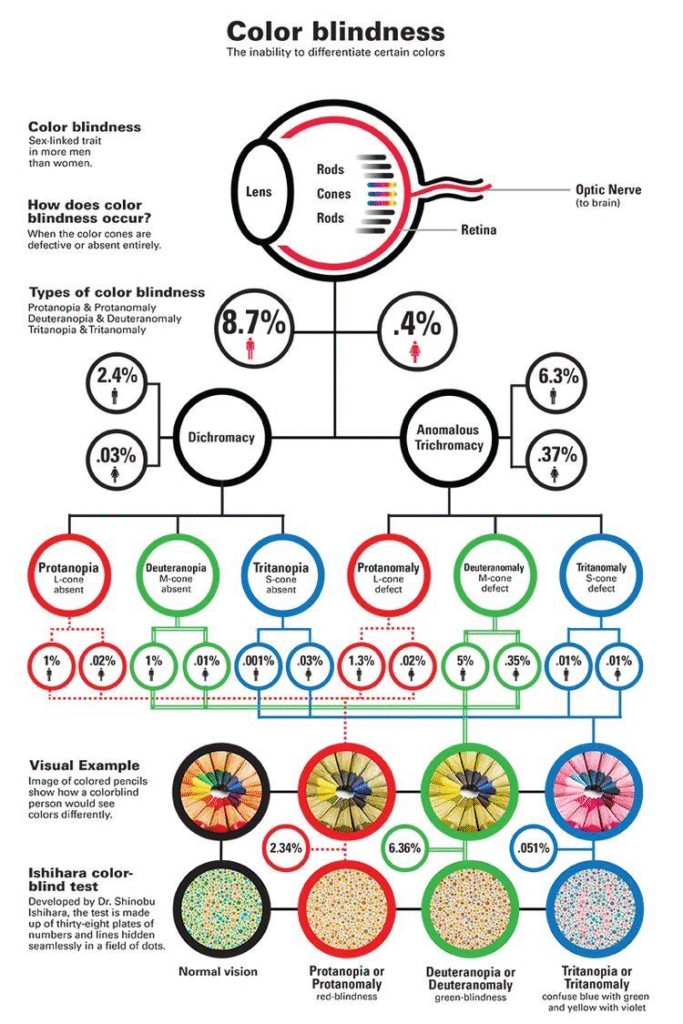
What color does a Color Blind Person See?Understanding Color Blindness: Types, Causes, and Testing

What is Color Blindness?
Color blindness is a visual condition in which a person cannot differentiate between certain colors. It occurs when color-sensitive cells (cones) in the retina are defective or missing. The condition is typically inherited and is a sex-linked trait, meaning it appears more frequently in men than in women because the genes responsible for color vision are located on the X chromosome.
How Does Color Blindness Occur?
The human eye contains two types of light-sensitive cells in the retina:
- Rods, which detect light and dark (helping with night vision), and
- Cones, which detect color.
There are three types of cones, each sensitive to a specific range of light wavelengths:
- L-cones for red light
- M-cones for green light
- S-cones for blue light
Color blindness occurs when one or more of these cones are absent or defective, altering how colors are perceived.
Types of Color Blindness
Color blindness can be categorized based on which cone type is affected:
1. Protan Defects (Red-Blindness)
- Protanopia: L-cone (red) is absent.
- Protanomaly: L-cone is defective.
- People with these conditions have trouble distinguishing red from green and may perceive reds as darker or brownish.
2. Deutan Defects (Green-Blindness)
- Deuteranopia: M-cone (green) is absent.
- Deuteranomaly: M-cone is defective.
- This is the most common type of color blindness. Reds and greens appear similar, making it difficult to differentiate traffic lights or ripe fruits.
3. Tritan Defects (Blue-Yellow Blindness)
- Tritanopia: S-cone (blue) is absent.
- Tritanomaly: S-cone is defective.
- People with tritan defects confuse blue with green and yellow with violet.
- These are very rare, affecting both men and women equally.
Prevalence of Color Blindness
- Protan defects: About 1% of men
- Deutan defects: About 5% of men
- Tritan defects: Around 0.01% of the population
- Overall, approximately 8% of men and 0.5% of women have some form of color vision deficiency.
Dichromacy and Anomalous Trichromacy
- Dichromacy: One type of cone is completely missing (e.g., protanopia, deuteranopia, tritanopia).
- Anomalous Trichromacy: All three cones are present, but one type is defective (e.g., protanomaly, deuteranomaly, tritanomaly).
People with anomalous trichromacy may see colors, but they are not as vivid or accurate.
Visual Example
If you were to look at a set of colored pencils, a person with normal vision would see a full spectrum of distinct colors. However, someone with protanopia or deuteranopia would see many of those colors blend together, making reds and greens appear nearly the same.
Testing for Color Blindness
The Ishihara Color Test is the most widely used method to detect color vision deficiencies.
- Developed by Dr. Shinobu Ishihara, it consists of 38 plates filled with colored dots that form numbers or paths.
- People with normal color vision can read the hidden numbers easily, while those with color blindness will either see different numbers or none at all.
- The test helps identify whether a person has red-green or blue-yellow deficiencies.
Living with Color Blindness
Although there is no cure for inherited color blindness, most individuals adapt well.
- Special tinted lenses can sometimes improve color distinction.
- Mobile apps and digital filters help identify colors correctly in daily tasks.
- Education and awareness are key—especially for children—so teachers can adjust materials that rely heavily on color coding.
Conclusion
Color blindness is not a limitation but a different way of seeing the world. Understanding its causes and types helps in early detection and adjustment, ensuring that individuals with color vision deficiency can lead normal, fulfilling lives. With awareness and supportive tools, the world remains full of color—just seen through a different lens.
